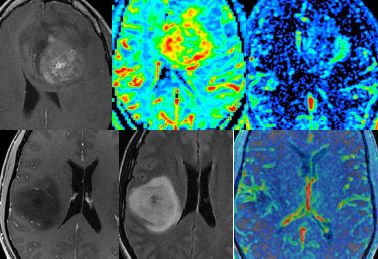UTILIDAD DE LOS PARÁMETROS DE PERMEABILIDAD DERIVADOS DE LA PERFUSIÓN T1 Y LA PERFUSIÓN T2* EN LA EVALUACIÓN PRE QUIRÚRGICA DE LOS GLIOMAS DIFUSOS
Palabras clave:
GLIOMAS DIFUSOS, poster, seram, PARÁMETROS DE PERMEABILIDAD, PERFUSIÓN T2*, PERFUSIÓN T1Resumen
Objetivos
- Comparar los parámetros de permabilidad obtenidos a partir de la perfusión T1 y T2*
- Evaluar la exactitud diagnóstica de los parámetros de permeabilidad a la hora de discriminar gliomas de alto y bajo grado
- Analizar la relación de los parámetros de permeabilidad con la supervivencia global (SG) y con la supervivencia libre de progresión (SLP)
- Estimar las diferencias en términos de permeabilidad de los gliomas de alto grado clasificados en función del estadio molecular (mutación IDH, MGMT y ATRX)
MATERIAL Y MÉTODOS
SELECCIÓN DE PACIENTES Y ANÁLISIS HISTOLÓGICO
Desde febrero de 2014 hasta julio de 2016, realizamos un estudio retrospectivo de 49 pacientes con gliomas difusos confirmados histológicamente
Después de la resección quirúrgica o de la biopsia, dos neuropatólogos con experiencia proporcionaron el diagnóstico histológico utilizando la clasificación de la OMS 2007
Las muestras histológicas se clasificaron en gliomas de grados II, III y IV en función de la presencia de morfología celular astrocítica u oligodendroglial, densidad celular, atipia, actividad mitótica, proliferación vascular y necrosis
Los gliomas de alto grado también se subclasificaron desde el punto de vista molecular en función del estado IDH, MGMT y ATRX
Descargas
Citas
Mills SJ, Plessis D du, et al. Mitotic Activity in Glioblastoma Correlates with Estimated Extravascular Space Derived from Dynamic Contrast Enhanced MR Imaging. AJNR Am J Neuroradiol 2016;37:811-17
Nguyen TB, Cron GO, Mercier JF, et al. Preoperative Prognostic Value of Dynamic Contrast Enhanced MRI Derived Contrast Transfer Coefficient and Plasma Volume in Patients with Cerebral Gliomas. AJNR Am J Neuroradiol 2015;36:63-69
Choi YS, Kim DW, Lee SK, et al.The Added Prognostic Value of Preoperative Dynamic Contrast Enhanced MRI Histogram Analysis in Patients with Glioblastoma: Analysis of Overall and Progression Free Survival. AJNR Am J Neuroradiol 2015;36:2235-41
Hilario A, Ramos A, Perez Nuñez A, et al. The added value of apparent diffusion coefficient to cerebral blood volumen in the preoperative grading of diffuse gliomas. AJNR Am J Neuroradiol 2012;33:701-7
Nguyen TB, Cron GO, Perdrizet K, et al. Comparison of the Diagnostic Accuracy of DSC and Dynamic Contrast Enhanced MRI in the Preoperative Grading of Astrocytomas. AJNR Am J Neuroradiol 2015;36:2017-22
Mills SJ, Patankar TA, Haroon HA, et al. Do cerebral blood volume and contrast transfer coefficient predict prognosis in human glioma? AJNR Am J Neuroradiol 2006;27:853-58
Law M, Yang S, Babb JS, et al. Comparison of cerebral blood volume and vascular permeability from dynamic susceptibility contrast enhanced perfusion MR imaging with glioma grade. AJNR Am J Neuroradiol 2004;25:746-55
Skinner JT, Moots PL, Ayers GD, et al. On the Use of DSC MRI for Measuring Vascular Permeability. AJNR Am J Neuroradiol 2016;37:80-87
Louis DN, Ohgaki H, Wiestler OD, et al. The 2007 WHO Classification of Tumors of the Central Nervous System. Acta Neuropathol 2007;114:97-109
Lacerda S, Law M. Magnetic resonance perfusion and permeability imaging in brain tumors. Neuroimaging Clin N Am 2009;19:527-57
Tofts PS, Brix G, Buckley DL, et al. Estimating kinetic parameters from dynamic contrast enhanced T(1) weighetd MRI of a diffusible tracer: standardized quantities and symbols. J Magn Reson Imaging 1999;10:223-232
Hilario A, Sepulveda JM, Perez Nuñez A, et al. A prognostic model based on preoperative MRI predicts overall survival in patients with diffuse gliomas. AJNR Am J Neuroradiol 2014;35(6):1096-102
Jia Z, Geng D, Xie T, et al. Quantitative analysis of neovascular permeability in glioma by dynamic contrat enhanced MR imaging. Journal of Clinical Neuroscience 2012;19:820-23
Alcaide Leon P, Pareto D, Martinez Saez E, et al. Pixel by Pixel Comparison of Volume Transfer Constant and Estimates of Cerebral Blood Volume from Dynamic Contrast Enhanced and Dynamic Susceptibility Contrast Enhanced MR Imaging in High Grade Gliomas. AJNR Am J Neuroradiol 2015;36(5):871-6
Zaharchuck G. Theoretical basis of hemodynamic MR imaging techniques to measure cerebral blood volume, cerebral blood flow, and permeability. AJNR Am J Neuroradiol 2007;28:1850-58
Choi HS, Kim AH, Ahn SS, et al. Glioma grading capability: comparisons among parameters from dynamic contrast enhanced MRI and ADC value on DWI. Korean J Radiol 2013;14(3):487-92
Szopa W, Burley TA, Kramer Marek G, et al. Diagnostic and Therapeutic Biomarkers in Glioblastoma: Current Status and Future Perspectives. BioMed Res Int 2017 Feb 20. doi 10.1155/2017/8013575
Pekmezci M, Rice T, Molinaro AM, et al. Adult infiltrating gliomas with WHO 2016 integrated diagnosis: additional prognostic roles of ATRX and TERT. Acta Neuropathol 2017 Mar 2. doi 10.1007/s00401 017 1690-1
Eckel Passow JE, Lachance DH, Molinaro AM. Glioma Groups Based on 1p/19q, IDH, and TERT Promoter Mutations in Tumors. N Engl J Med 2015;372:2499-2508
Ahn SS, Shin N Y, Chang JH, et al. Prediction of methylguanine methyltransferase promoter methylation in glioblastoma using dynamic contrast enhanced magnetic resonance and diffusion tensor imaging. J Neurosurg 2014;121:367-373


